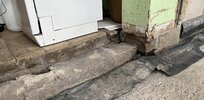- Joined
- 12 Mar 2025
- Messages
- 4
- Reaction score
- 0
- Country

Hi,
go easy on a lady!
looking at our new extension walls, it looks like the DPC on the inner wall is higher than the original house. The floor joists in original house are sat on a wall, and I think an old DPC material... this level is lower than the DPC hanging from the walls in the new extension. I would assume that the level the joists are set at would be the DPC level.... you wouldn't have a damp layer above the floor joists... as joists sit in the wall too....?
if so, how much of an issue is this at the point where they (should) meet? should building control have spotted this? if it is wrong, are BC somehow liable?
any advice appreciated... I am not an expert... or even the start of being an expert...
kind thanks,
J
go easy on a lady!
looking at our new extension walls, it looks like the DPC on the inner wall is higher than the original house. The floor joists in original house are sat on a wall, and I think an old DPC material... this level is lower than the DPC hanging from the walls in the new extension. I would assume that the level the joists are set at would be the DPC level.... you wouldn't have a damp layer above the floor joists... as joists sit in the wall too....?
if so, how much of an issue is this at the point where they (should) meet? should building control have spotted this? if it is wrong, are BC somehow liable?
any advice appreciated... I am not an expert... or even the start of being an expert...
kind thanks,
J

